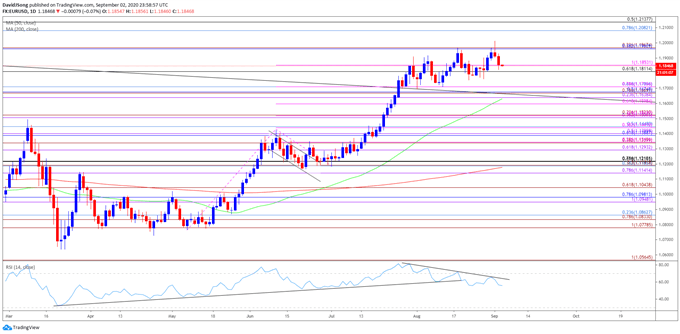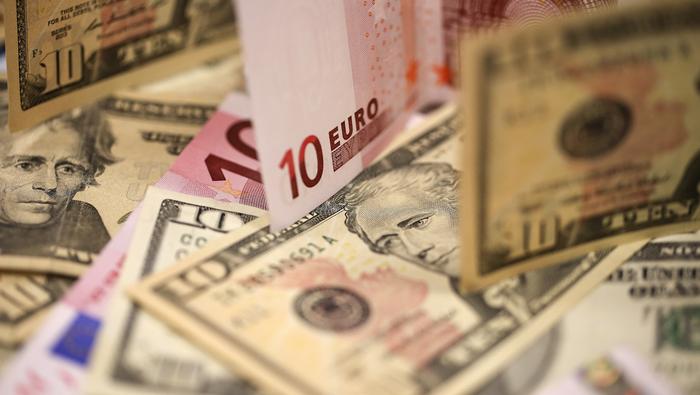EUR/USD Rate Talking Points
EUR/USD cleared the August range to tag a fresh yearly high (1.2011), but the exchange rate struggles to retain the advance following the Federal Reserve Economic Symposium as the Relative Strength Index (RSI) continues to track the downward trend carried over from the previous month.
EUR/USD Outlook: RSI Reveres from Trendline Resistance Ahead of NFP
EUR/USD initiates a series of lower highs and lows in September even though Federal Reserve officials offer more detailsregarding the changes to the Statement on Longer-Run Goals and Monetary Policy Strategy, and the exchange rate may face a larger pullback ahead of the US Non-Farm Payrolls (NFP) report as the RSI reverses from trendline resistance to preserve the bearish formation established in August.

The NFP report may produce increased volatility in EUR/USD as the update is anticipated to show the US economy adding 1.4 million jobs in August, and a further improvement in the labor market may lead to a bullish reaction in the US Dollar as it puts pressure on the Federal Open Market Committee (FOMC) to adopt a less-dovish forward guidance for monetary policy.
However, signs of a protracted recovery may drag on the Greenback as the FOMC relies on its non-standard tools to support the US economy, and it remains to be seen if the fresh data prints will influence the monetary policy outlook as Chairman Jerome Powell and Co. plans to “achieve inflation that averages 2 percent over time.”
In turn, current market trends may continue to sway EUR/USD ahead of the next Fed interest rate decision on September 16 as the crowding behavior in the US Dollar looks poised to persist, with retail traders net-short the pair since mid-May.

The IG Client Sentiment report shows 41.63% of traders are net long EUR/USD, with the ratio of traders short to long at 1.40 to 1. The number of traders net-long is 22.87% higher than yesterday and 6.81% higher from last week, while the number of traders net-short is 11.62% lower than yesterday and 10.11% lower from last week.
The jump in net-long position has helped to alleviate the tilt in retail sentiment as only 31.64% of traders were net-long EUR/USD at the start of the week, but open interest has fallen 3.76% from the previous week amid the decline in net-short interest.
It seems as though the crowding behavior in the US Dollar will linger over the coming days, but a further shift in retail sentiment may highlight a potential change in market behavior as the FOMC discusses an outcome-based approach versus a calendar-based forward guidance for monetary policy.
With that said, current market trends may keep EUR/USD afloat as the exchange rate tags a fresh 2020 high (1.2011) in September, but the exchange rate may face a larger pullback as long as the RSI preserves the downward trendcarried over from the previous month.



Sign up and join DailyFX Currency Strategist David Song LIVE for an opportunity to discuss key themes and potential trade setups surrounding foreign exchange markets.
EUR/USD Rate Daily Chart

Source: Trading View
- Keep in mind, a ‘golden cross’ materialized in EUR/USD towards the end of June as the 50-Day SMA (1.1632) crossed above the 200-Day SMA (1.1178), with the moving averages extending the positive slopes into the second half of the year.
- At the same time, a bull flag formation panned out following the failed attempt to close below the 1.1190 (38.2% retracement) to 1.1220 (78.6% expansion) region in July, with the Relative Strength Index (RSI) helping to validate the continuation pattern as the oscillator bounced along trendline support to preserve the upward trend from March.
- However, the EUR/USD rally stalled following the failed attempt to break/close above the 1.1960 (38.2% retracement) to 1.1970 (23.6% expansion) region, with the RSI highlighting a similar dynamic as it slipped below 70 to flash a textbook sell signal.
- A similar scenario appears to be taking shape in September as EUR/USD quickly pulls back from a fresh yearly high (1.2011) and initiates a series of lower highs and lows as it struggles to close above the 1.1960 (38.2% retracement) to 1.1970 (23.6% expansion) region.
- EUR/USD may face a larger pullback as the RSI reverses from trendline resistance to preserve the bearish formation carried over from the previous month, with a break/close below the 1.1810 (61.8% retracement) to 1.1850 (100% expansion) region opening up the Fibonacci overlap around 1.1670 (50% retracement) to 1.1710 (61.8% retracement), which lines up with the August low (1.1696).
- Nevertheless, future developments in the RSI may help to validate a near-term breakout in EUR/USD once the indicator takes out the downward trend established in August, with a move above 70 likely to be accompanied by a further appreciation in the exchange rate like the behavior seen in July.
- Need a close above the 1.1960 (38.2% retracement) to 1.1970 (23.6% expansion) region to bring the May 2018 high (1.1996) on the radar, with the next area of interest coming in around 1.2080 (78.6% retracement) to 1.2140 (50% retracement).



--- Written by David Song, Currency Strategist
Follow me on Twitter at @DavidJSong






